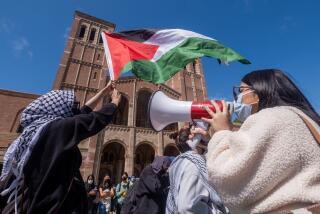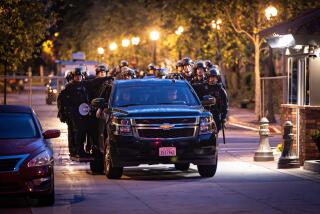Kashmiris savor a victory
SRINAGAR, INDIA — The students at the University of Kashmir have freedom on their minds.
Not from the tyranny of exams and professors, or of too-strict parents. What many young people here are dreaming of is freedom for their divided land, instead of being caught in the middle of a decades-old tug of war between India and Pakistan.
They got a taste of self-rule recently when thousands of residents rose up against a government decision to set aside forest land for use by Hindu pilgrims visiting a shrine here in India’s only predominantly Muslim state, Jammu and Kashmir. The protests, in which at least six people were killed, were the biggest in years and forced not only an official reversal but the collapse of the state government this month.
It was a rare triumph of people power in the eyes of many Kashmiris, none more so than the youthful agitators in their teens and 20s who formed the majority of those chanting in the streets.
“It was like we were celebrating our freedom,” said law student Saaqib Amin, 27, savoring the memory. “People on the roads talked about when we get freedom how much we will celebrate.”
India and Pakistan each control parts of the contested Himalayan region, but both claim it in full and have gone to war twice over it. If nothing else, the protests put India on notice that it has yet to convince the younger generation of the benefits or justice of its rule in this part of Kashmir.
After nearly two decades of fighting between the Indian army and Kashmiri Muslim militants, some backed by Pakistan, New Delhi has won few hearts and minds here on its side of the divide, where unremitting bloodshed is almost all that many have ever known.
More than 60,000 people have been killed since disaffected groups took up arms in 1989 to press for independence or a merger with Pakistan, according to human rights groups. Civilians have been slain by militants’ bombs and grenades; others have been kidnapped, tortured and killed by Indian security forces.
Violence has receded in the last few years amid peace talks between India and Pakistan, but tragedy still scars this land of breathtaking natural beauty, where an estimated half a million Indian troops remain posted, their fatigues and automatic weapons everywhere in evidence.
Here in Srinagar, the summer capital of the Indian state, there is anger at both the militants and the Indian security forces. But much more of it is reserved for the latter.
“We are the children of conflict. That shaped our minds,” said Shahid Mohammed Lon, 22. “I’ve seen people butchered before me by Indian troops. I see that India is not my friend.”
His dormitory mates nodded in agreement as they sat around talking on the leafy campus of the University of Kashmir.
They nodded even more vigorously when Lon, a mass-communications major, explained that, for members of his generation, those slogans of the ‘90s that demanded unification with Muslim brothers and sisters in Pakistan have given way to shouts for full-blown independence.
That is anathema to the leaders of both India and Pakistan. But such a scenario may not be so unacceptable to the Indian and Pakistani public. In a rare survey of attitudes toward Kashmir on either side of the de facto border, a U.S.-based polling firm reported this month that only 35% of Indians and 11% of Pakistanis would oppose independence if the majority of Kashmiris wanted it.
Despite the more peaceful atmosphere these days, it is difficult to find anyone here who is content with the status quo.
“We can’t stay in an environment like this. Change is necessary. You cannot stay in an occupied land,” said Maroosha Muzaffar, 23.
“It’s up to youth to come out and stage protests and change things for themselves,” she added. “They have the passion. They have the energy.”
The recent land protests were a timely vehicle for channeling that energy. The uproar centered on the state government’s decision to transfer 99 acres of land to a Hindu trust that runs a pilgrimage to the Amarnath shrine in southern Kashmir, where a giant ice stalagmite inside a cave is worshiped as a symbol of the god Shiva. Each year, thousands make the pilgrimage during a two-month period in the summer to see the stalagmite as it waxes. The land was to be used for rest stops and other facilities for pilgrims.
To many Kashmiris, for whom land is a highly emotive aspect of local identity, the transfer was too much. Some suspected a government plot to bring more Hindus to Kashmir to dilute its Muslim majority. Environmentalists also opposed the move.
The strength of the ensuing protests, which erupted in mid-June and continued for two weeks, took many aback, including the demonstrators themselves, who turned out in numbers not seen since the 1990s. Hindu activists mounted counter-protests after the government decided July 1 to rescind the land grant.
Ironically, it was the decline in violence and the improving relations between India and Pakistan that, in many ways, made such agitation possible.
During the blood-soaked years of militant attacks and army reprisals, there was no space for a popular grass-roots movement. Now, civil society has begun cautiously to bloom.
With the land protests, “the movement became again purely indigenous, purely Kashmiri,” said political scientist Gul Mohammed Wani. “It was quite unprecedented. . . . Suddenly the people took it on their own shoulders.”
That so many of those shoulders belonged to the young was due in part to demographics. In the Kashmir Valley, more than two-thirds of the population is younger than 35.
But beyond that, experts detect a rising sense of political and economic discontent among Kashmiri youths. About 400,000 young people are unemployed, half of them with bachelor’s degrees. Many complain of discrimination when they apply for jobs in other parts of India, where human rights groups say police routinely detain and harass young Kashmiri men.
The pent-up resentment and anger helped drive young people out to protest and to support the demonstrations from behind the scenes. On the university campus, students organized blood drives as the number of people injured in clashes with security forces grew.
After the government reversed itself, they celebrated along with millions of other Kashmiris, and hoped it would be a sign of things to come.
“Surely India will take heed of what the Kashmiri people are demanding,” said Lon, the mass-communications major. “Kashmiri people are not to be taken for granted. . . . They were trying to push [us] to the wall, but Kashmiris bounced back.”
--
More to Read
Sign up for Essential California
The most important California stories and recommendations in your inbox every morning.
You may occasionally receive promotional content from the Los Angeles Times.











